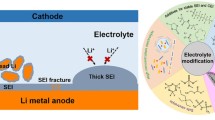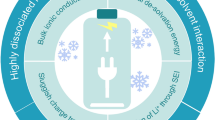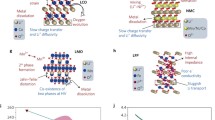Abstract
Lithium-ion batteries (LIBs) have garnered great attention owing to their high specific energy and power compared with other batteries. Currently, the use of LIBs is expanded to the power source of mid- or large-sized devices such as electric vehicles, energy storage devices, and so on. For the stable operation of such devices, LIBs should deliver their battery performance under the daily-life temperature, i.e., from − 20 to 60 °C. In so far as, direct modification of the electrolyte system is considered the most effective among various strategies. Herein, we investigated various carbonate-based electrolyte systems for LIBs. The effect of the compositions and additives of the electrolyte on the battery performance was scrutinized. Therefore, we could provide an understanding of the electrolyte design rule, which enables LIBs to work under the desired temperature.
Graphical Abstract











Similar content being viewed by others
References
Nykvist, B., Nilsson, M.: Rapidly falling costs of battery packs for electric vehicles. Nat. Clim. Chang. 5(4), 329–332 (2015)
Tran, M., et al.: Realizing the electric-vehicle revolution. Nat. Clim. Chang. 2(5), 328–333 (2012)
Kim, J., et al.: A stepped mesh host for lithium metal batteries inspired by transmission electron microscopy sampling grids. Electron. Mater. Lett. (2023). https://doi.org/10.1007/s13391-023-00474-9
Kang, C.-Y., et al.: Boosting electrochemical performance of Ni-rich layered cathode Via Li2SnO3 surface coating and sn4+ gradient doping based dual modification for lithium-ion batteries. Electron. Mater. Lett. 19(4), 374–383 (2023)
Feng, Y., et al.: Challenges and advances in wide-temperature rechargeable lithium batteries. Energy Environ. Sci. 15(5), 1711–1759 (2022)
Zhang, X., Yang, Y., Zhou, Z.: Towards practical lithium-metal anodes. Chem. Soc. Rev. 49(10), 3040–3071 (2020)
Gupta, A., Manthiram, A.: Designing advanced lithium-based batteries for low-temperature conditions. Adv. Energy Mater. 10(38), 2001972 (2020)
Dahn, J.R., et al.: Rechargeable LiNiO2/carbon cells. J. Electrochem. Soc. 138(8), 2207 (1991)
Xu, K., Ding, M.S., Jow, T.R.: Quaternary onium salts as nonaqueous electrolytes for electrochemical capacitors. J. Electrochem. Soc. 148(3), A267 (2001)
Jasinski, R.J., Kirkland, S.: Analysis and distillation of propylene carbonate. Anal. Chem. 39(13), 1663–1665 (1967)
Owen, J.R.: Rechargeable lithium batteries. Chem. Soc. Rev. 26(4), 259–267 (1997)
Sun, X., et al.: Improved elevated temperature cycling of LiMn2 O 4 spinel through the use of a composite LiF-based electrolyte. Electrochem. Solid-State Lett. 4(11), A184 (2001)
Markevich, E., et al.: Fluoroethylene carbonate as an important component in electrolyte solutions for high-voltage lithium batteries: role of surface chemistry on the cathode. Langmuir 30(25), 7414–7424 (2014)
Komaba, S., et al.: Fluorinated ethylene carbonate as electrolyte additive for rechargeable Na batteries. ACS Appl. Mater. Interfaces 3(11), 4165–4168 (2011)
Peled, E., et al.: An advanced tool for the selection of electrolyte components for rechargeable lithium batteries. J. Electrochem. Soc. 145(10), 3482 (1998)
Aurbach, D., et al.: A short review on the comparison between Li battery systems and rechargeable magnesium battery technology. J. Power. Sources 97–98, 28–32 (2001)
Le Mehaute, A., et al.: Polymer electrolytes. Polym. Bull. 14(3), 233–237 (1985)
Tarascon, J.M., Guyomard, D.: New electrolyte compositions stable over the 0 to 5 V voltage range and compatible with the Li1+xMn2O4/carbon Li-ion cells. Solid State Ionics 69(3), 293–305 (1994)
Zhang, S.S., Xu, K., Jow, T.R.: A new approach toward improved low temperature performance of Li-ion battery. Electrochem. Commun. 4(11), 928–932 (2002)
Zhang, N., et al.: Critical review on low-temperature Li-Ion/metal batteries. Adv. Mater. 34(15), 2107899 (2022)
Yuan, M., Liu, K.: Rational design on separators and liquid electrolytes for safer lithium-ion batteries. J. Energy Chem. 43, 58–70 (2020)
Wang, Y., et al.: Theoretical studies to understand surface chemistry on carbon anodes for lithium-ion batteries: reduction mechanisms of ethylene carbonate. J. Am. Chem. Soc. 123(47), 11708–11718 (2001)
Zhang, X., et al.: A review on thermal management of lithium-ion batteries for electric vehicles. Energy 238, 121652 (2022)
Guyomard, D., Tarascon, J.M.: Rechargeable Li1 + x Mn2 O 4/carbon cells with a new electrolyte composition: potentiostatic studies and application to practical cells. J. Electrochem. Soc. 140(11), 3071 (1993)
Aurbach, D., et al.: The study of electrolyte solutions based on ethylene and diethyl carbonates for rechargeable Li batteries: II. graphite electrodes. J. Electrochem. Soc. 142(9), 2882 (1995)
Tarascon, J.M., Armand, M.: Issues and challenges facing rechargeable lithium batteries. Nature 414(6861), 359–367 (2001)
Zhang, S.S.: A review on electrolyte additives for lithium-ion batteries. J. Power. Sources 162(2), 1379–1394 (2006)
Nie, M., et al.: Effect of vinylene carbonate and fluoroethylene carbonate on SEI formation on graphitic anodes in Li-Ion batteries. J. Electrochem. Soc. 162(13), A7008–A7014 (2015)
Nguyen, C.C., Lucht, B.L.: Comparative study of fluoroethylene carbonate and vinylene carbonate for silicon anodes in lithium ion batteries. J. Electrochem. Soc. 161(12), A1933–A1938 (2014)
Burns, J.C., et al.: Studies of the effect of varying vinylene carbonate (VC) content in lithium ion cells on cycling performance and cell impedance. J. Electrochem. Soc. 160(10), A1668–A1674 (2013)
Shin, H., et al.: Effects of fluoroethylene carbonate (FEC) on anode and cathode interfaces at elevated temperatures. J. Electrochem. Soc. 162(9), A1683–A1692 (2015)
Teufl, T., et al.: Implications of the thermal stability of FEC-based electrolytes for Li-Ion batteries. J. Electrochem. Soc. 170(2), 020531 (2023)
Pritzl, D., et al.: Analysis of vinylene carbonate (VC) as additive in graphite/LiNi0.5Mn1.504cells. J. Electrochem. Soc. 164(12), A2625–A2635 (2017)
Zhi, H., et al.: Understanding how nitriles stabilize electrolyte/electrode interface at high voltage. J. Phys. Chem. Lett. 8(24), 6048–6052 (2017)
Farhat, D., et al.: Towards high-voltage Li-ion batteries: Reversible cycling of graphite anodes and Li-ion batteries in adiponitrile-based electrolytes. Electrochim. Acta 281, 299–311 (2018)
Hu, Z., et al.: A Novel electrolyte additive enables high-voltage operation of nickel-rich oxide/graphite cells. J. Phys. Chem. Lett. 12(18), 4327–4338 (2021)
Kerner, M., et al.: Towards more thermally stable Li-ion battery electrolytes with salts and solvents sharing nitrile functionality. J. Power. Sources 332, 204–212 (2016)
Kim, Y.S., Lee, H., Song, H.K.: Surface complex formation between aliphatic nitrile molecules and transition metal atoms for thermally stable lithium-ion batteries. ACS Appl. Mater. Interfaces 6(11), 8913–8920 (2014)
Hu, P., et al.: Progress in nitrile-based polymer electrolytes for high performance lithium batteries. J. Mater. Chem. A 4(26), 10070–10083 (2016)
Acknowledgements
This study was funded by Ministry of Trade, Industry, and Energy of Korea and supported by the Materials/ Parts Technology Development Program of the Korea Evaluation Institute of Industrial Technology (20011287). This research was supported by “Regional Innovation Strategy (RIS)” through the National Research Foundation of Korea(NRF) funded by the Ministry of Education(MOE)(2021RIS-001).
Author information
Authors and Affiliations
Corresponding authors
Ethics declarations
Conflict of interest
Authors declare no conflict of interest.
Additional information
Publisher's Note
Springer Nature remains neutral with regard to jurisdictional claims in published maps and institutional affiliations.
Supplementary Information
Below is the link to the electronic supplementary material.
Rights and permissions
Springer Nature or its licensor (e.g. a society or other partner) holds exclusive rights to this article under a publishing agreement with the author(s) or other rightsholder(s); author self-archiving of the accepted manuscript version of this article is solely governed by the terms of such publishing agreement and applicable law.
About this article
Cite this article
Kim, OJ., Cho, YH., Kang, JJ. et al. Exploration about the Electrolyte System of Li-ion Batteries for the Wide Temperature Range Operation. Electron. Mater. Lett. (2024). https://doi.org/10.1007/s13391-024-00488-x
Received:
Accepted:
Published:
DOI: https://doi.org/10.1007/s13391-024-00488-x




